‘Behemoth’ is a word which springs to mind or, perhaps more nautically, ‘leviathan’.
- Spacious for a 36-footer
- Responsive handling and strong performance
- Stylish interior
- Two or three-cabin layout options
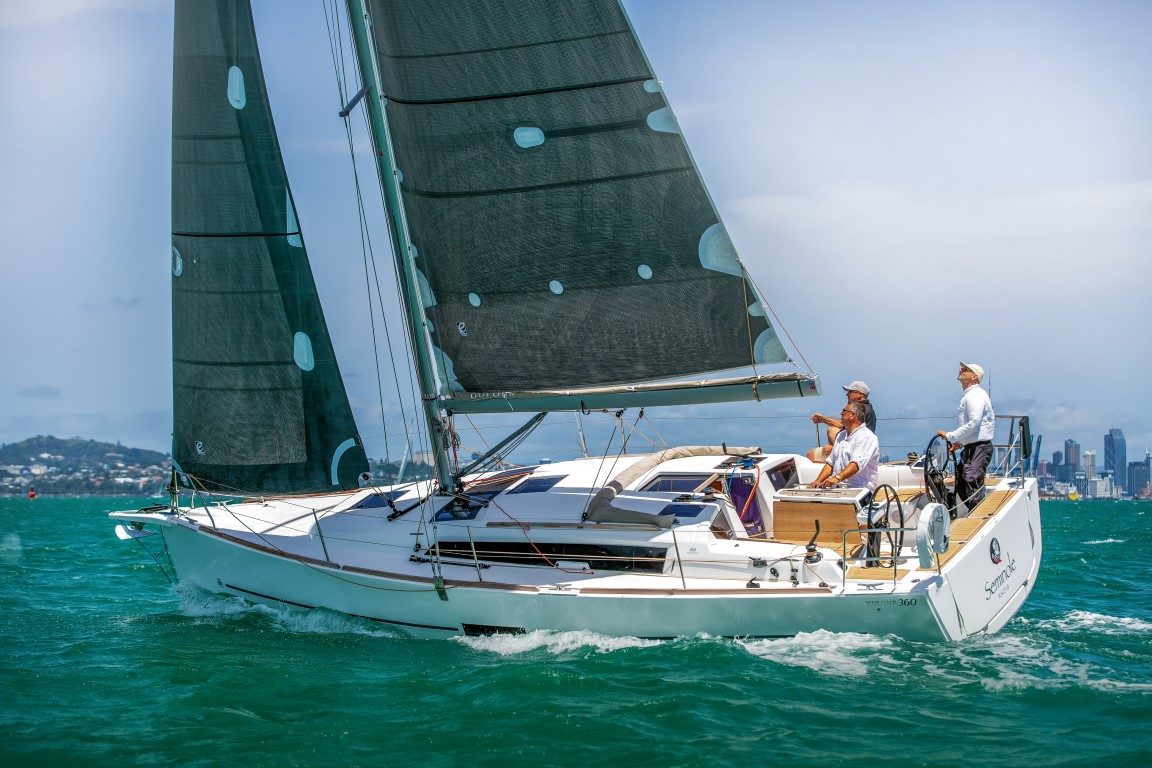
Ten-metre cruiser/racers been a staple of many major production boatbuilders for over four decades now. No surprise because this class ticks lots of boxes for the average family; small enough for easy two-handing, big enough for cruising and offering competitive club racing for those so inclined.
Enter the Dufour 360 Grand Large. First off, don’t let the 360 fool you. While this model measures 10.73m overall, the hull itself is only 9.9m. Like all the Dufour Grand Large range, the 360’s been designed by the Italian-based Felci Yacht Design, a marriage of Italian flair and French GRP production boatbuilding expertise.

Owners Liam and Ann Power have only just taken delivery of Seminole, having purchased the yacht through Flagship Marine, the Dufour agents for the past three years. Flagship Marine representatives spent four days in the Dufour factory checking the brand out before taking it on.
“Dufour does a few things in the background that give its boats more structural integrity than some others,” says Power. “Keel floors glassed to the hull instead of just bogged, the internal grid going further forward as well as back to the rudder post – elements of construction you might not see in the finished boat, but nice to know they are there.”
Dockside
Power, who served his time as a boatbuilder under John Lidgard and has done considerable sailing in the past, is excited about getting back into sailing again with Seminole. And the meaning of her name? The South Florida Indian word for ‘runaway’.
For a 10m hull, the feeling of room below is amazing and numerous windows maximise the feeling of light and space. There are three options for the interior timbers – mobi (a type of mahogany), teak or oak, along with soft fabric choices. This one’s finished in teak.
 But the major decision facing a potential owner is the choice between two or three cabins. The galley, saloon and forward cabin remain the same for both models – the difference is aft. The three-cabin model features twin sleeping cabins either side of the cockpit with the head immediately forward of the starboard one, opposite the galley.
But the major decision facing a potential owner is the choice between two or three cabins. The galley, saloon and forward cabin remain the same for both models – the difference is aft. The three-cabin model features twin sleeping cabins either side of the cockpit with the head immediately forward of the starboard one, opposite the galley.
The two-cabin model swaps out the starboard aft cabin for a massive cockpit locker, a chart table and seat, and a slightly bigger head compartment located further aft. Seminole is the two-cabin version, which would be my choice too.
Having the chart table gives a nice place to sit to play with the trick electronics package, including twin multi-function displays, soft touch switch panel and digital read outs for fuel and water. If you get bored with this, there’s a 12-bottle wine rack immediately adjacent at the foot of the companionway.
Accessed either through a seat in the cockpit or a hatch in the aft of the heads compartment, the cockpit locker is a beauty and capable of swallowing massive amounts of gear which would otherwise have to find a home downstairs.

A Z Spars fractional rig is held in column with deep, well-angled double spreaders, the lower set being nearly as wide as the yacht. There’s no backstay as standard, but Power has added twin Dyneema running backstays to counter the loads of the gennaker in heavy conditions. “More for peace of mind than anything,” he says.
All the sailing controls apart from the sheets run aft through channels set into the cabin top to twin banks of four jammers either side of the main hatch, so there’s nothing to trip over when handling the mainsail.

Twin Lewmar 40 winches are located in moulded recesses aft of these with their drums level with the jammers. Another pair of winches, again Lewmar 40s, sit on the coamings immediately forward of the helm to handle the double-sided mainsheet. These can be jammed off to free the winches if required.
Considerable attention to detail has gone into the twin helm stations, which I find far more convenient than a single wheel. Besides a multi-function display mounted in the aft face of each cockpit coaming, the starboard helm has a pedestal pod containing engine start panel, rev counter and auto pilot controls.
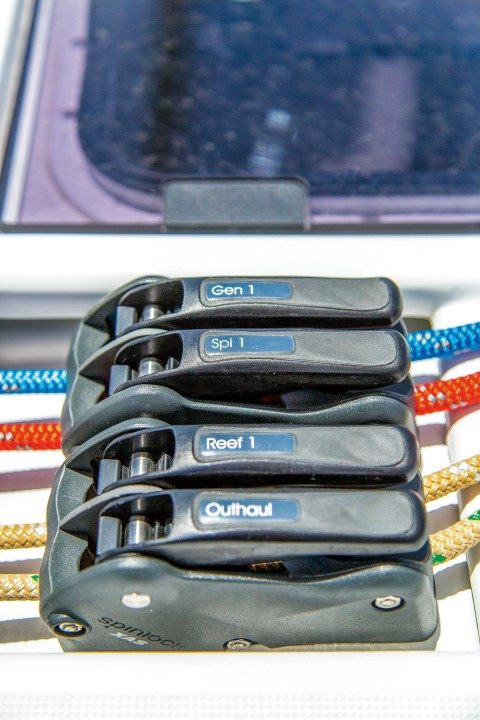 Its sister pod to port contains a magnetic compass, plus the controls for the 12” chartplotter located centrally at the rear of the cockpit table. There are lift-up foot panels in the cockpit floor for bracing yourself at the helm when heeled.
Its sister pod to port contains a magnetic compass, plus the controls for the 12” chartplotter located centrally at the rear of the cockpit table. There are lift-up foot panels in the cockpit floor for bracing yourself at the helm when heeled.
Aft of the wheels is cunningly-hidden BBQ and a water basin in the aft coaming, with a dedicated life raft locker the yacht prefers to be kept on her feet, a tuck in the main around the 20-knot mark upwind seems to be the key to easy handling.
The mainsheet arrangement could be improved. The standard system is German style, with mainsheet blocks attached to a bridle located athwartships and the double-ended mainsheet running forward to the mast, then back either side to the aft cockpit winches. With this arrangement, because there is no proper mainsheet track and adjustable car, the vang becomes doubly important.
In a bid to ease the load on the vang, Power had removed the bridle and instead attached the mainsheet blocks direct to the bridle beckets. The jury’s out on this arrangement as we found mainsail control awkward in this breeze and Power’s considering going back to the standard set up. Let’s not forget, though, that this was only the second time Power had sailed Seminole so he’s still on a learning curve. I’m sure the mainsheet system will soon be properly sorted.
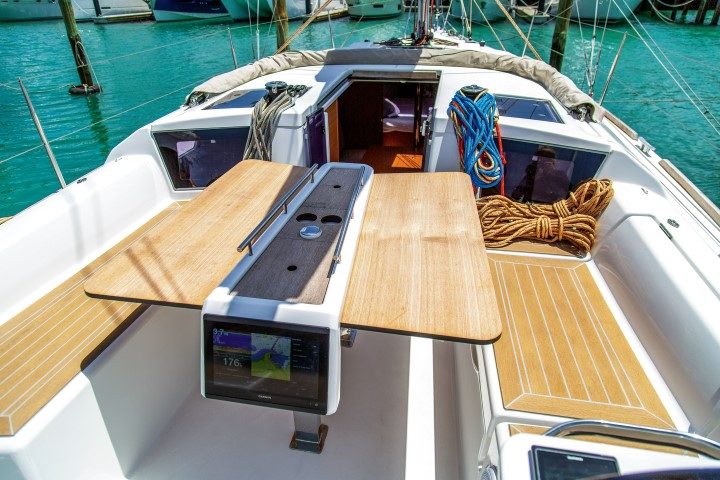
The standard Dufour self-tacker is an excellent feature and performed faultlessly. Tacking’s simply a matter of calling the tack and winding the helm. The self-tacker is a 95% blade, which is plenty in breezes over 15 knots – the bigger 106% is designed for lighter breezes. While both are reefable, most times it will be the mainsail that’s reefed first.
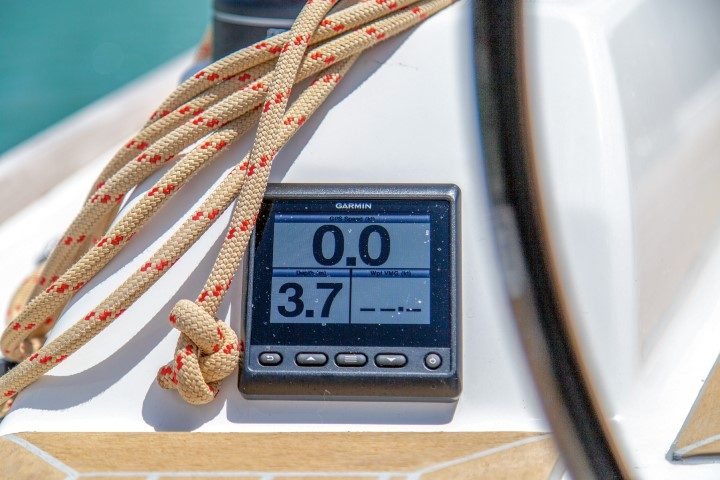
On the surface the Dufour shares many similarities with other European offerings in the 10m cruiser/racer class; buoyant, high-sided hull with soft chines aft, fractional rig and a well-styled interior. But it appears Dufour is aiming its version at the well-heeled rather than the budget end of this class, with an emphasis towards cruising. There’s a definite feeling of elegance, flair and attention to detail.
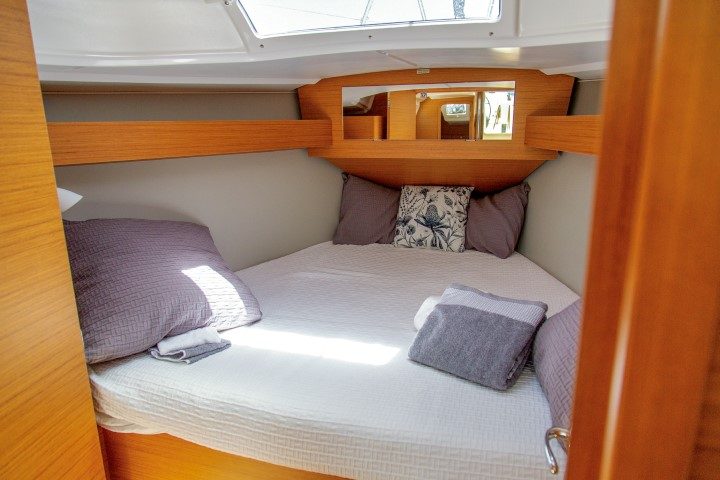
Adding the locally-built, higher performance sails has provided a significant boost over the standard sail wardrobe and consequently Seminole has the potential to become more than a nuisance to racing competitors at club level.
In short, she’s a classy cruiser/racer with a turn of speed.
The sails
Keen to maximise Seminole’s racing potential, Power approached Rodney Keenan of Evolutions Sails for new sails. They settled on a five-sail wardrobe; square-topped main, two headsails, a Code Zero and gennaker.
The square-topped main and furling headsails have been laminated in Evolution’s Henderson factory from Expedition Carbon/Technora membrane. This combination of materials, besides being considerably lighter, will hold the design shape throughout the effective working life.
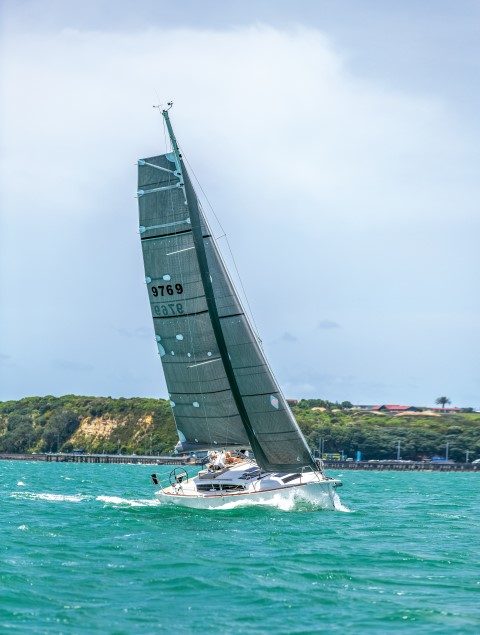 The top two mainsail battens are full length, while the lower two have been kept short to prevent excessive chafe and S bending over the aft swept spreaders. According to Keenan, the square-top main is easier to trim than a standard pin head because the square-top encourages twisting. Despite its impressive area, he feels it adds little to the loads on the mast. The smaller headsail is self-tacking while the larger one sheets to tracks abaft the mast. Both are roller reefing/furling on a Facnor furler and feature vertical leech battens to allow a positive leech for more area and keep the leech shape under control.
The top two mainsail battens are full length, while the lower two have been kept short to prevent excessive chafe and S bending over the aft swept spreaders. According to Keenan, the square-top main is easier to trim than a standard pin head because the square-top encourages twisting. Despite its impressive area, he feels it adds little to the loads on the mast. The smaller headsail is self-tacking while the larger one sheets to tracks abaft the mast. Both are roller reefing/furling on a Facnor furler and feature vertical leech battens to allow a positive leech for more area and keep the leech shape under control.
Interestingly, Evolution uses a special two-pack paint for the UV strip on the headsails rather than usual sacrificial fabric. This makes the sail lighter and doesn’t ruin its shape in light winds.
The Technoa Code Zero furls on a Ronstan furler, while the nylon gennaker resides in a sock.
Naturally enough these classier fabrics come with a price premium; in this case around 50% more than traditional sails. However, this upfront extra is mitigated by the lighter weight, better shape and longer lifespan.
‘Behemoth’ is a word which springs to mind or, perhaps more nautically, ‘leviathan’.
White Pointer has earned the respect of discerning customers in New Zealand and Australia, attracting a loyal and ever growing following for its high-quality, rugged and totally dependable aluminium trailer boats.
The hardtop SP635 shares the same underpinnings as the popular SF 635 which was a completely new model back in 2020.
The pride and joy of a multi-generational family, Bliss resides on a pier that’s home to a couple of other Elite motor launches – Sandspit Marina is a hot-spot for the Bill Upfold-designed vessels, with several calling this small marina home.